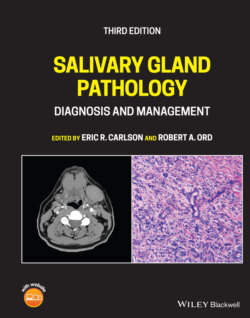Читать книгу Salivary Gland Pathology - Группа авторов - Страница 100
Adenoid cystic carcinoma
ОглавлениеAdenoid cystic carcinoma has similar characteristics as mucoepidermoid carcinoma in that their imaging findings are based on histologic grade. Adenoid cystic carcinoma is the most common malignant neoplasm of the submandibular and sublingual glands as well as the minor salivary glands in the palate. These tumors have a high rate of local recurrence, higher rate of distance metastases as opposed to nodal disease, and may recur after a long latency period (Madani and Beale 2006b). MRI is the imaging method of choice, demonstrating high signal due to increased water content. Contrast‐enhanced fat saturated images are critical to evaluate for perineural spread, which is demonstrated by nerve thickening and enhancement (Madani and Beale 2006b; Shah 2002). CT can be helpful to evaluate bone destruction or foraminal widening. It is important to define the tumors' extent and identify perineural invasion into the skull base (Figures 2.67 through 2.71 ).
Figure 2.64. Axial contrast‐enhanced CT demonstrating an ill‐defined mass diagnosed as a mucoepidermoid carcinoma (arrow).
Figure 2.65. Axial contrast‐enhanced CT demonstrating large bulky cervical lymphadenopathy with ill‐defined borders, diagnosed as a mucoepidermoid carcinoma.
Figure 2.66. Reformatted coronal contrast‐enhanced CT demonstrating an ill‐defined heterogeneous density mass diagnosed as a mucoepidermoid carcinoma (arrow).
Figure 2.67. Coronal contrast‐enhanced MRI of the skull base demonstrating a mass extending through the skull base via the left foramen ovale (arrow), diagnosed as an adenoid cystic carcinoma originating from a minor salivary gland of the pharyngeal mucosa.
Figure 2.68. Axial CT in bone window demonstrating a mass eroding through the left side of the hard palate and extending into the maxillary sinus (arrow) diagnosed as adenoid cystic carcinoma.
Figure 2.69. Coronal CT corresponding to the case illustrated in Figure 2.68 with a mass eroding the hard palate and extending into the left maxillary sinus (arrow).
